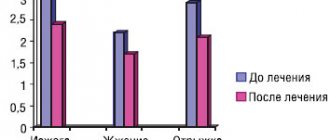Belching
Belching
is a sudden and involuntary release of gases from the esophagus and stomach through the mouth. Belching is caused by contraction of the stomach muscles when the cardiac sphincter (the ring of muscle that separates the esophagus and stomach) is open. The cardiac sphincter is a muscular valve that allows food to enter the stomach but prevents it from flowing back into the esophagus. However, if too much gas has accumulated in the stomach, the body needs to get rid of it. The sphincter opens and the stomach muscles contract, squeezing gases into the esophagus and then into the oral cavity. This is the mechanism of belching. In this case, gases released from the stomach, as a rule, have a specific, unpleasant odor. The movement of gases can entrain particles of stomach contents, which, when they hit the taste buds, can cause unpleasant taste sensations. Sound can also be considered an undesirable manifestation of belching: since burping occurs uncontrollably, the loudness of a burp can ruin the situation and bring discomfort to our communication with other people. Therefore, it is natural to try to avoid belching.
Types and causes of occurrence
There are two types of belching - physiological and pathological. The first type is characterized by the release of gases up to two times daily. Often the process occurs when snacking on the run, constantly talking during meals, dry snacks, overeating and abuse of soda and dairy products. This process is considered a normal variant and does not require treatment.
Pathological belching is a symptom of diseases of the digestive tract, worsening up to ten times a day. Repeated cases of belching indicate dysfunction of the liver, gallbladder, and stomach. Most often, the release of gases through the mouth occurs with gastritis, gastric and duodenal ulcers, gastroduodenal reflux, gastroduodenitis, esophageal hernia, impaired gastric pH, impaired outflow of bile.
Belching can be empty or airy, bitter, sour, with food residues, with the taste of acetone, rotten.
Vasilenko V.V. About belching and periodic vomiting / www.gastroscan.ru.
| Authors: Vasilenko V.V. |
Belching
Belching is the most common “digestive symptom” that patients unknowingly associate with any digestive disease.
In fact, the reason lies in a disorder of the nervous regulation of digestive functions. In other words, the more you think about belching, the longer it will bother you, the less you think about it, the faster it will go away. There are no universal methods of drug treatment yet - regular autogenic training and breathing exercises can give results (the method is outlined below).
Meliora probant, deteriora sequuntur. - I praise the good, but I am drawn to the bad
Belching air can occur after a vigorous meal in anyone.
Moreover, sometimes excessive burping becomes habitual. People with neurological disorders who swallow a lot of air outside of meals belch air constantly.
Dysregulation of the motor function of the stomach leads to severe and persistent belching. Aerophagy is an unconscious act that is not necessarily associated with food intake. During one swallowing movement, 2–3 ml of air enters the stomach. Typically a person swallows 600 times per day. Aerophagia, as one of the official independent so-called functional gastroduodenal disorders, is characterized by a feeling of fullness in the epigastric region, which occurs as a result of excessive swallowing of air and decreases after belching with air. It should be remembered that air is not formed in the stomach, but gets there when it is involuntarily swallowed and is retained.
In order to overcome persistent belching, it is necessary to carefully master any of the abundant systems of self-relaxation, meditation or autogenic training, and at the same time search for and select a suitable psychotropic medicine with the help of a doctor. A powerful suggestion can have an unexpectedly quick effect: medical hypnosis (unfortunately, there are practically no specialists) or the psychological influence of strong personalities - be it Kashpirovsky, a healer, a healer or a clergyman (medical education does not play any role). Sometimes, as Montaigne said, one simply “must be able to endure what cannot be avoided.”
It is impossible not to mention the vomiting syndrome, which often misleads children’s doctors and “adult” doctors.
Periodic vomiting
Since 1882, the syndrome of periodic vomiting has been known, appearing in otherwise completely healthy children.
It has two variants of its course: classic - monotonous episodes of nausea and vomiting of varying duration are observed (and intervals of normal well-being can last for weeks and months); chronic - mild nausea with almost daily vomiting (reminiscent of some diseases of the digestive system). The faster the patient’s symptoms (pain, vomiting, diarrhea) disappear thanks to the medicine, the less inclined he is to follow other medical recommendations - quitting smoking, diet, etc. Unfortunately, even a clear explanation that improvement does not mean recovery is far from doesn't always help. N.V. Elshtein
The conditions are similar, but with certain features. They are also found in adults. They can last for years and even decades. In some cases, triggering factors are found - usually stress (not only negative, but also positive), and in women also the onset of menstruation.
First, nausea is felt, which is accompanied by general and muscle weakness. Then there are attacks of uncontrollable vomiting, often with bile or even blood, and abdominal pain.
In about a quarter of patients, body temperature and blood pressure increase, and the pulse quickens. General blood tests do not reveal inflammatory changes. In this phase of the syndrome, features of psychotic behavior are often observed. Then the attacks (reminiscent of vomiting in pregnant women - early toxicosis, as well as the so-called hysterical vomiting) suddenly or gradually stop.
Between episodes of vomiting, two-thirds of patients experience migraines, panic attacks, signs of anxiety or mood disorders, and alcohol or drug abuse.
Only a doctor, based on strictly defined criteria, can diagnose periodic vomiting syndrome and its phase by analyzing the family history and manifestations of the disease, excluding other probable causes of nausea and vomiting that can be successfully treated.
What is now considered a drug will become poison tomorrow. So what? The sick will again consider this poison a medicine. Rudaki
However, the correct diagnosis is usually made late, and treatment also leaves much to be desired. Patients repeatedly turn to doctors and, at their insistence, repeat examinations to no avail.
Thus, the results of observation of 38 people with periodic vomiting syndrome showed that in total they underwent 62 gastroscopy and 17 operations (usually removal of the gallbladder).
Long-term studies confirm a favorable prognosis in terms of physical health and the absence of serious complications. The general recommendation for the acute phase of periodic vomiting syndrome is to create conditions for maximum rest and prolonged sleep. If necessary, an individual selection of medications is possible to reduce the frequency of exacerbations, pause the process, speed up recovery, and alleviate the symptoms of exacerbations.
Therapeutic breathing exercises
In some cases, special physical therapy can significantly improve a person’s well-being and general condition.
However, in case of serious diseases of the lungs or bronchi, before mastering a set of exercises, of course, you need to consult a doctor.
Breathing exercises are mastered in three stages. When performing each exercise, it is important to mentally imagine the nature of the movement, its connection with breathing and the pace of execution. The original system of exercises was proposed by I.B. Temkin, O.A. Sheinberg and P.I. Anikeev. It should not be viewed as something obligatory and unchangeable. After gradual, solid mastery, these exercises should be included separately in morning gymnastics complexes, in other independent physical education classes; they can be performed during walks and even during lunch breaks.
When mastering gymnastics, practice in the fresh air or on the balcony, in the bedroom with an open window and, if possible, alone. Do the exercises daily, preferably 20 minutes every day rather than an hour twice a week. Clothing should be soft, loose, and not restrict movement.
Music is not required, but Chopin or Tchaikovsky, rather than peppy rhythms, will help you relax and switch over.
First stage
Mastering the first stage usually requires 10–12 independent sessions with a gradual increase in the duration of the exercises. With the help of an experienced physical therapy methodologist, you can master gymnastics three times faster.
A. Static
breathing exercises (lying on your back, side, sitting and standing).
- Rhythmic nasal breathing with the mouth closed at a normal pace (duration 30–60 seconds).
- The same thing with mentally counting the number of inhalations and exhalations through the nose (15–30–60 seconds).
- Rhythmic breathing through one nostril while holding the other nostril with your hand, alternately 3-4 times (30-60 seconds).
- Abdominal breathing. Trying to keep your chest motionless, while inhaling, protrude the front wall of your abdomen as much as possible, especially its lower part. As you exhale, vigorously draw in your abdominal wall. For visual control of the correct movements, hands should be held on the chest and stomach (4-8-12 times).
- Chest breathing. Trying to keep the front wall of the abdomen motionless, while inhaling, expand the chest as much as possible. When exhaling, on the contrary, the chest should be vigorously compressed. Breathe through your nose. For control, the hands are on the sides of the chest (4–8–12 times).
- Full breath. As you inhale, expand your chest while simultaneously protruding the front wall of your abdomen. Exhalation begins with a vigorous retraction of the abdominal wall and subsequent compression of the chest. Breathe through your nose. For control, one hand is on the chest, the other on the stomach (4-8-12 times).
- Exercise in voluntarily slowing down the breathing rhythm and simultaneously deepening it, breathing through the nose (30–60–120 seconds).
B. Dynamic
breathing exercises (there is only one in the first stage).
- Uniform nasal breathing combined with walking at a slow pace (in place or in motion). It can be carried out in the form of imitation of walking from starting positions lying or sitting. The exhalation is slightly longer than the inhalation, both phases are performed for a certain number of steps (60–120–180 seconds).
Second stage
At the first stage, you have to consistently learn static breathing exercises for conscious mastery of the breathing mechanism and the ability to control it.
The second stage involves the use of static breathing exercises of the first stage and additional static exercises, as well as dynamic exercises. At this stage, special attention is paid to the ability to voluntarily change the rhythm, tempo and amplitude of breathing movements. Mastering it usually requires 10–12 independent sessions with a gradual increase in the duration of the exercises.
A. Static
breathing exercises (lying on your back, on your side, sitting and standing).
- Uniform breathing with inhalation through the nose and jerky, in 2-3 steps, exhale through the mouth (3-6 times).
- Even breathing with inhalation through the nose and extended exhalation through the mouth while pronouncing vowels or consonants (3-6 times).
- Method of breathing with counter movements. During inhalation, the chest expands and the abdomen retracts. Accordingly, when you exhale, the chest contracts and the stomach protrudes. Perform the exercise rhythmically, without tension and silently. Breathe through your nose (4–8–12 times). This exercise is borrowed from Chinese breathing exercises.
- Inhale slowly through your nose. Exhale in one quick movement through the mouth. Then hold your breath for 3-5 seconds (4-8 times).
- Take a quick deep breath in through your mouth, exhale slowly through your nose (4-8 times).
B. Dynamic
breathing exercises.
- Lying on your back, sitting or standing, legs together. Raising your arms through your sides - inhale. Return to the starting position - exhale (3-6 times).
- In a sitting or standing position. Hands to the side. Voluntary breathing when rotating the arms in the shoulder joints back and forth - 4 times in each direction (4-6 times).
- In a sitting or standing position. Feet shoulder-width apart, arms bent, hands clenched into fists. Strikes simulating boxing strikes (8-10 times with each hand). Breathing is uniform.
- Lying on your back, sitting or standing. Feet together, hands on waist. Taking the straight leg to the side and returning to the starting position - inhale, pause - exhale (6-8 times in each direction).
- Lying on your back, sitting or standing. Legs extended together, arms down. Alternating bending of the legs at the knee joints. When performing the exercise, exhale, when returning to the starting position, inhale (6-8 times with each leg).
- In a sitting or standing position. Feet shoulder-width apart, arms along the body. Bend the torso forward - exhale, return to the starting position - inhale (4-8 times).
- Lying, sitting or standing. Feet together, arms to the sides. Bend the torso to the sides. When performing the exercise, exhale; when returning to the starting position, inhale (4–8 times in each direction).
Third stage
The third stage is the development of breathing skills under conditions of increased stress, the development of correct breathing when performing household and professional stress. Classes include breathing exercises during long walks, sports exercises or games, etc. The duration of mastering this stage is longer - 30–35 independent studies.
A. Static
breathing exercises.
Starting position: standing, feet shoulder-width apart, knees slightly bent, tailbone, heels and crown in line. Look straight ahead. Relax your shoulders and lower them. Place your hands on your stomach.
I. Mastering the rules of diaphragmatic breathing: while inhaling, lower the diaphragm, protrude your stomach slightly. As you exhale, on the contrary, draw in. The exhalation is slightly longer than the inhalation. Breathe evenly through your nose at your usual pace. Match your movements to your breathing, not the other way around. II. The actual exercises.
- Practice diaphragmatic breathing with your eyes closed (this will help you concentrate). Do not hurry! Practice your breathing until it becomes natural for you, and only then add new movements.
- As you exhale, bend your knees, and as you inhale, straighten them. Move up and down, constantly adjusting to your breathing. The lower you sit, the greater the load.
- Imagine that your hands are lying on a cushion of air: palms at shoulder level, fingers “looking” down, elbows slightly lowered. Don't pinch your armpits. As you exhale, squat, your hands lower to hip level, as if you are stroking the air. As you inhale, rise up, and also move your arms up (at first, to control your breathing, you can leave one hand on your stomach).
B. Dynamic
breathing exercises.
- Starting position: lying on your back. Legs together, arms freely (depending on the strength of the abdominal muscles). Going to a sitting position - exhale, returning to the starting position - inhale (6-8-12 times).
- Starting position: standing. Feet together, hands on waist. Squat - exhale, return to the starting position - inhale (6-10-15 times).
- Starting position: standing. Feet together, hands on waist. Jumping - breathing evenly (20–40–60 times).
- Even breathing when running in place or while moving at a slow to medium pace (30–60 seconds).
- Deep nasal breathing when walking up stairs along a planned route.
- Breathing when swimming is through the mouth; shortened energetic inhalation and extended exhalation.
V.V. Vasilenko. Sixty essays on digestion (recommendations from a gastroenterologist to patients) Back to section
Which doctor treats belching
If belching is a frequent occurrence, then you need to consult a gastroenterologist.
To make an appointment with a doctor, choose any method:
- call the clinic +7 (495) 103-99-55,
- order a call back,
- leave a request for an appointment using a convenient form on the website:
Many people think that belching is a symptom that does not require much concern. This is true if belching occurs as a physiological phenomenon.
IMPORTANT! If belching becomes permanent, then you should consult a gastroenterologist, because the symptom may indicate the development of serious diseases of the gastrointestinal tract.
Make an appointment with an experienced and qualified gastroenterologist at the Kuntsevo Medical and Rehabilitation Center to understand the individual causes of belching, as well as get advice on how to eliminate the symptom.
SIGN UP
Symptoms of the disease
It is already known that the appearance of belching is affected by many diseases of the stomach and intestines. They, in turn, have certain symptoms that can occur in parallel with belching.
- Gastroesophageal reflux pathology: this is the most common cause of air escaping from the stomach. Appears during changes in body position. In addition to belching, there are: chest pain, nausea and vomiting, rapid saturation of the stomach, cough, shortness of breath. The development of this condition is preceded by the following factors: overeating, smoking, use of medications, inactivity. This disease can trigger the development of ulcers or erosion of the esophagus.
- Gastritis: characterized by inflammatory processes in the gastric mucosa. Signs of pathology are not only belching, but also: nausea, pain, bouts of vomiting, heaviness in the stomach. If gastritis has an atrophic form, putrefactive belching appears against the background of rapid satiety. The skin becomes pale and nails become brittle. With non-atrophic gastritis, sour belching occurs.
- Stomach ulcer: in addition to belching, it is manifested by pain, nausea, constipation and refusal to eat. Very similar to the symptoms of gastritis, so you need to be extremely careful during diagnosis.
- Stomach cancer: this is a progressive and rapidly developing pathology, the symptoms of which are very similar to gastritis. Main symptoms: low appetite, rapid satiety, sudden weight loss, heaviness.
- Pathology of the esophagus: diseases of this part of the digestive organs provoke the appearance of belching. Signs that the esophagus has pathologies are: a feeling of a lump in the throat, difficulty swallowing, chest pain, sudden weight loss, heartburn. If the disease develops, inflammatory processes will appear. Irreversible changes will occur in it, which will cause a lot of discomfort while eating.
- Supragastric belching: a form of belching in which air comes out only from the esophagus. A person can control and call it independently. When a patient complains about this reaction of the body, it should be assumed that he does not control his actions and needs the help of a psychotherapist.
Treatment methods
First of all, the doctor is interested in the diet and prescribes an examination to examine in detail the condition of the digestive tract. Modern equipment installed within the walls of our clinic allows gastroscopy to be performed quickly and without pain.
Next, based on the diagnostic results, the gastroenterologist establishes a diagnosis and develops treatment tactics for each patient individually.
Drug therapy involves taking adsorbent, antacid drugs, and anti-inflammatory drugs to combat the inflammatory process of the tissues of the internal organs of the gastrointestinal tract. They create a protective layer on the walls of the stomach, collapse gases, and speed up the process of digesting food. In some cases, the gastroenterologist recommends taking a course of physical therapy to improve intestinal motility.
Treatment of belching is impossible without correcting the diet. So, you need to exclude foods such as cabbage, brown bread, baked goods with yeast, legumes, and carbonated drinks. Along with the main therapy, alkaline mineral water is prescribed to reduce stomach acidity.
Key points
Belching is not a disease, but only a symptom. In a healthy person, it can appear when swallowing a large amount of air, overeating, or stressful situations. Eructation is a sign not only of digestive disorders, but also of diseases of the nervous system.
Belching is often observed with gastritis, peptic ulcer, reflux esophagitis, pancreatitis, duodenitis. If erection is accompanied by additional symptoms, you should immediately go to a specialist. Treatment should be aimed primarily at eliminating the underlying pathology.
Prevention
Belching is a signal that comes from the digestive system. Therefore, for prevention, you first need to adjust your diet and lifestyle (Fig. 2). Eliminate carbonated drinks, fatty and spicy foods, and sweets from your diet. Eat wisely: monitor your own body’s reaction to different foods. Don't eat while running or while talking, stop smoking, reduce your alcohol intake, and stop chewing gum.
Figure 2. Habits that will help you get rid of belching. Source: MedPortal
Diagnostics
Photo: kot64 / freepik.com
An examination to clarify the cause of concern is carried out by a therapist or gastroenterologist. Research methods prescribed by doctors:
- general blood and urine analysis,
- stool analysis,
- detection of the presence of the bacterium Helicobacter pylori (usually using the PCR method),
- gastroscopy (for gastritis),
- pH-metry (for increased stomach acidity),
- Ultrasound,
- radiography,
- MRI.




